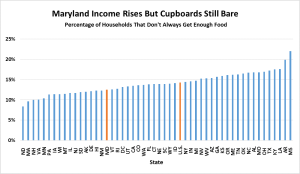Thousands of Maryland Families Struggle to Put Food on the Table
Despite rising incomes in our state, one in eight Maryland families still struggle to put enough food on the table each day. It is clear that not all Marylanders have benefitted from the economic recovery that those at the top have been fortunate to experience.
The rate of households in Maryland that at one time or another aren’t sure where their next meal is coming from has remained the same, even with falling unemployment and a rising household median income, suggesting that many hard-working people still aren’t paid enough to meet their families’ most basic needs.
One of the wealthiest states in the country, Maryland ranks 17th among states in the percentage of households unable to afford sufficient food for their families to live an active, healthy lifestyle. Nearly 13 percent of Marylanders (757,430) experienced this situation in 2014, according to the U. S. Department of Agriculture, including about one third who actually missed some meals because they couldn’t afford to buy food. Families in Baltimore City are nearly twice as likely as residents in other parts of the state to have trouble affording enough food.
Between 2012 and 2014, an average of 12.5 percent of Maryland households could not afford enough food – exactly the same as the prior two-year average (2009-2011).
Of even greater concern is that, over the past decade, the percentage of households in our state that can’t afford enough to eat has grown by almost 45 percent, when comparing the time periods of 2002-2004 to 2012-2014.
Maryland hasn’t done enough to address this problem. Passing the Hunger-Free Schools Act this year –ensuring that all children in 277 schools get breakfast and lunch – was a step in the right direction, but we can’t stop there.
What will make the greatest difference is ensuring that our economy provides opportunity for all Marylanders and that hard-working people are paid enough to cover the costs of housing, food, child care, and other basic necessities.
Expanding the state’s Earned Income Tax Credit also would help, by putting more money in the pockets of low-paid working families and young people just getting their start in the workforce – money they would immediately spend in local food markets, increasing economic activity and benefiting businesses and the communities where they are located.
It is also essential that government and nonprofit leaders work collaboratively to expand and improve participation in federal nutrition programs, and make sure those programs are strong enough to support everyone who needs help getting back on their feet.

